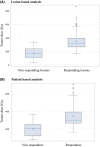High impact of macroaggregated albumin-based tumour dose on response and overall survival in hepatocellular carcinoma patients treated with 90 Y-loaded glass microsphere radioembolization
- PMID: 27514012
- PMCID: PMC5217069
- DOI: 10.1111/liv.13220
High impact of macroaggregated albumin-based tumour dose on response and overall survival in hepatocellular carcinoma patients treated with 90 Y-loaded glass microsphere radioembolization
Abstract
Background & aims: Efficacy of radioembolization is derived from radioinduced damage, whereas tumour dosimetry is not considered as yet in prospective clinical trials.
Objectives: This study evaluates the impact of tumour dose (TD), based on 99m Tc macroaggregated albumin (MAA) quantification, on response and overall survival (OS).
Materials and methods: We consecutively included 85 patients with hepatocellular carcinoma treated with 90 Y-loaded glass microspheres. TD was calculated using a quantitative analysis of the MAA SPECT/CT. Responses were assessed after 3 months using the European Association for the Study of the Liver criteria. OS was assessed using Kaplan-Meier tests.
Results: Response rate was 80.3% on lesion-based analysis (n=132), and 77.5% on patient-based analysis. The response rate was only 9.1% for patients with TD <205 Gy against 89.7% for those with TD ≥205 Gy (P<10-7 ). Non-portal vein thrombosis (PVT) patients exhibited a median OS of 11.75 m (95% CI: 3-30.7 m) for TD <205 Gy, and 25 m (95% CI: 15-34.7 m) for TD ≥205 Gy (P=.0391). PVT patients exhibited a 4.35 m median OS (95% CI: 2-8 m) for TD<205 Gy, and 15.7 m (95% CI: 9.5-25.5 m) for TD ≥205 Gy, (P=.0004), with HR of 6.99. PVT patients exhibited a median OS of 3.6 m (95% CI: 2-8 m) when PVT MAA targeting was poor or with TD <205 Gy (poor candidate), vs 17.5 m (95% CI: 11-26.5 m) for the others identified as good candidates (P<.0001), with HR of 12.85.
Conclusion: This study confirms the highly predictive value of MAA-based TD evaluation for response and OS. TD evaluation and PVT MAA targeting should be further evaluated in ongoing trials, whereas personalized dosimetry should be implemented in new trial designs.
Keywords: overall survival; predictive dosimetry; radioembolization; response.
© 2016 The Authors Liver International Published by John Wiley & Sons Ltd.
Figures



Comment in
-
Radioembolization for hepatocellular carcinoma: gaining insight on a personalized approach.Liver Int. 2017 Jan;37(1):32-34. doi: 10.1111/liv.13300. Liver Int. 2017. PMID: 28004531 No abstract available.
References
-
- El‐Serag HB, Mason AC. Rising incidence of hepatocellular carcinoma in the United States. N Engl J Med. 1999;340:745–750. - PubMed
-
- Salem R, Lewandowski RJ, Mulcahy MF, et al. Radioembolization for hepatocellular carcinoma using Yttrium‐90 microspheres: a comprehensive report of long‐term outcomes. Gastroenterology. 2010;138:52–64. - PubMed
-
- Hilgard P, Hamami M, Fouly AE, et al. Radioembolization with yttrium‐90 glass microspheres in hepatocellular carcinoma: European experience on safety and long‐term survival. Hepatology. 2010;52:1741–1749. - PubMed
-
- Mazzaferro V, Sposito C, Bhoori S, et al. Yttrium(90) radioembolization for intermediate‐advanced hepatocarcinoma: a phase II study. Hepatology. 2013;57:1826–1837. - PubMed
-
- Sangro B, Carpanese L, Cianni R, et al. European Network on Radioembolization with Yttrium‐90 Resin Microspheres (ENRY). Survival after yttrium‐90 resin microsphere radioembolization of hepatocellular carcinoma across Barcelona clinic liver cancer stages: a European evaluation. Hepatology. 2011;54:868–878. - PubMed
Publication types
MeSH terms
Substances
LinkOut - more resources
Full Text Sources
Other Literature Sources
Medical

